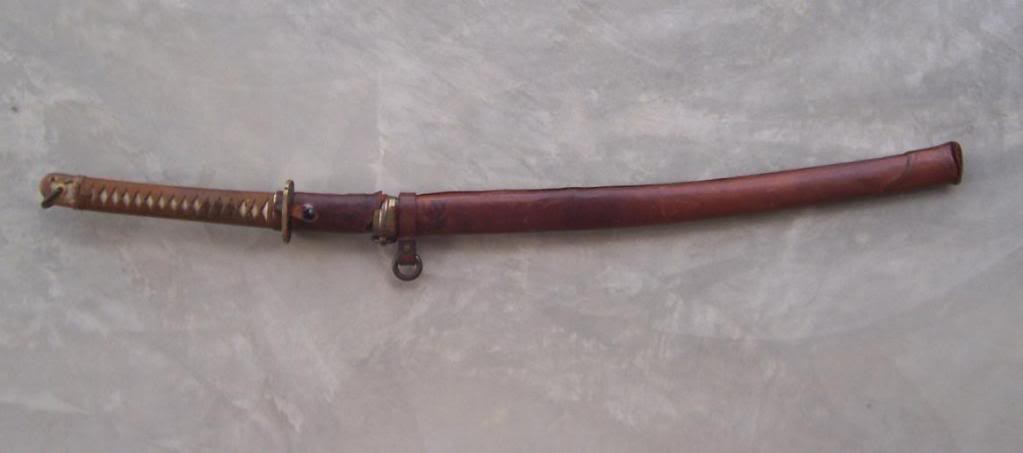-
FREE MEMBER
NO Posting or PM's Allowed

Another Japanese katana - GI capture
The story on this one was that it was collected off of Saipan. The hamon (temper line) follows the blade perfectly including out to the kisecki (tip) so I dont think the blade has had any major damage polished out. Polish is two tone, rough grit on the concave portion of the blade and bright on the top and sides of the tang. There are a few faint tiny pits here and there that the previous polisher decided not to try to remove when the blade was redone. This was some time ago as the blade shows lots of evidence of being drawn and reshealthed.
There are some scratches on one side where some dumbell tried to remove tarnish with a brillo pad. Nothing that couldnt be carefully removed. There are two mekugi pin holes in the nakago (one from the original tsuka (grip))and the saya looks more like a traditional shealth rather than the typical metal military one. The tsuka is military with a lanyard loop. The habaki (the little sleeve at the hilt) is what looks like nearly pure copper with maybe a hint of tin and is better fitted to the blade than a typical WWII sword. The menuki (the decorations under the wrapped grip) and tsuba (guard) are cherry blossomed themed.
The blade is convex, not hollow or flat ground, with no chips or dings in the edge. Its sharp. Not quite hair shaving sharp, but sharp enough to cleave the free standing corrugated box it was shipped in cleanly in two with a diagonal downward cut, and nearly halfway through on an immediate reverse upper cut. This was probably due to my amaturish skills at tamashegiri.
There is what looks an arsenal stamp above the writing. The twin mekugi holes and traditional saya make me wonder if this was a family or ancestral blade. Unfortunately, I cannot see a pattern in the metal that would indicate traditional folded and layered construction, but this may be because the blade is covered in oil and highly polished. I would like to translate the engraving on the nakago (tang). If anybody can help with this, it would be greatly appreciated.
The wooden saya (sheatlh) is light as a feather and beautifully constructed but unfortunately is delaminating, the laquer flaking, and is nearly useless functional wise. It is a very dark maroon color, not black. I suspect the leather cover was added to match it up to the brown ito wrap on the tsuka. The leather is very thin with a slight texture. It is reasonably gpod, but fragile and dry. Pigskin I presume. The stitching on it is coming apart on one side.
I would like to repair and repaint the saya but I dont know it this would hurt its value. Opinions?





Information
 |
Warning: This is a relatively older thread
This discussion is older than 360 days. Some information contained in it may no longer be current. |
|
-
10-31-2009 01:13 PM
# ADS
Friends and Sponsors

-
FREE MEMBER
NO Posting or PM's Allowed

 Information
Information


















 Register To Reply
Register To Reply










